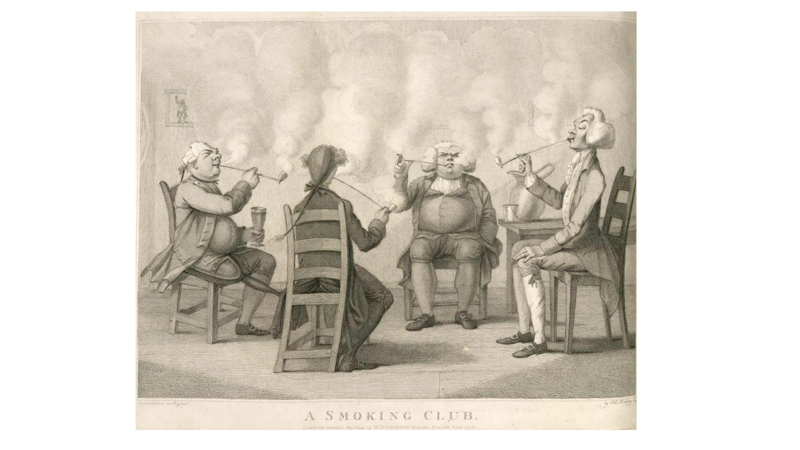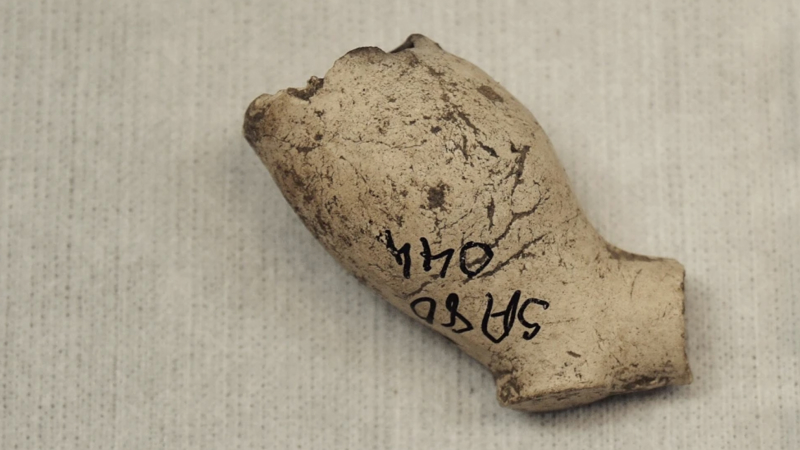Smoking the products of slavery

‘A Smoking Club’, (1859)
Digital Collections, The New York Public Library
20th September 2018
Glasgow was addicted to tobacco a long time before the era of its notorious Tobacco Lords. By the early 1600s smoking the exotic New World plant was becoming part of social life in Scotland and by the 1630s Glasgow merchants were importing and selling tobacco to the city’s new consumers. Loathed by James VI as a filthy habit, smoking was nonetheless fast becoming a trendy pastime throughout the country. Some doctors hailed tobacco for its medicinal uses and recommended smoking as a treatment for everything from arthritis, gout and ‘falling sickness’ (epilepsy) to blocked ears and panic attacks.
By the 1660s Glasgow had established itself as the most significant commercial centre in the West of Scotland, and was trading directly (and illegally) with the English plantations in the Caribbean and North America. The trade brought in many colonial goods produced by enslaved people such as indigo, ginger and cotton, and overwhelmingly, sugar and tobacco. These crops are what would set Glasgow on the path to unimaginable wealth over the course of the 1700s.

Clay pipe bowl
A.1998.1.341
This little clay pipe bowl was possibly imported from Holland. It was found in an archaeological excavation at the Gallowgate in Glasgow, and dates back to the mid-1600s.
Image © CSG CIC Glasgow Museums Collection
Tobacco was primarily grown in the English colonies of Maryland, Virginia and North Carolina. While initially cultivated by indentured servants, by the second half of the 1600s planters began replacing their workforce with enslaved Africans. Now dependent on slavery in order to be commercially viable, soaring American tobacco exports created a constant demand for more enslaved labour. For those Africans who fell victim to the slave trade, life on an American tobacco plantation was one of relentless, back breaking work, brutal punishments, fear, malnutrition, disease, and often, an early death. This is what underpinned Glasgow merchants’ access to tobacco, and, ultimately, what fed consumers’ voracious smoking habits.
With Glasgow’s tobacco trade came the related trades of tobacco spinning, snuff production and clay pipe manufacture, which were established in the city during the 1660s. Although snuff taking became increasingly popular, when tobacco was first introduced to Scotland it was smoked in clay pipes. As a monopoly on clay pipe manufacture was initially held by William Banks in Edinburgh, smokers in Glasgow often consumed their tobacco in pipes imported from Edinburgh or Holland.

Clay pipe fragment
A.2007.13.10.480
Clay pipe fragment made by James Colquhoun in Glasgow. This was found in an archaeological excavation on the site of the former Bishop’s Castle, where St Mungo’s Museum of Religious Art now stands.
Image © CSG CIC Glasgow Museums Collection
By 1667, if not a little earlier, clay pipe manufacturing was taking place in Glasgow in three different workshops. Of these, the workshop and family business of James Colquhoun was the most prominent. Their pipes can be identified by the moulded initials ‘I’ and ‘C’ on either side of the pipe bowl (J was often written as I at that time).
Clay pipe fragments found in archaeological excavations in Glasgow are very small and easy to miss, and dismiss.
However, if you take the time to consider what they represent, they convey a powerful message about Glasgow’s emerging relationship with tobacco and how the exploitation of enslaved people sustained it.
Katinka Stentoft Dalglish,
Curator of Archaeology
